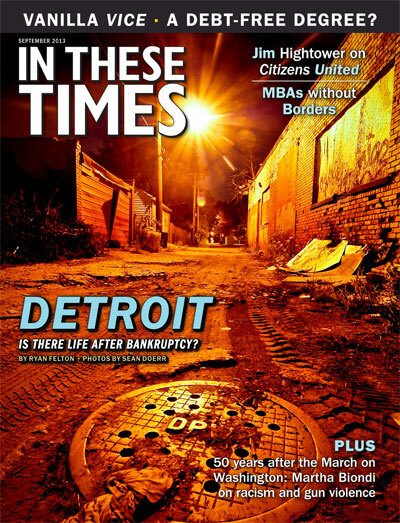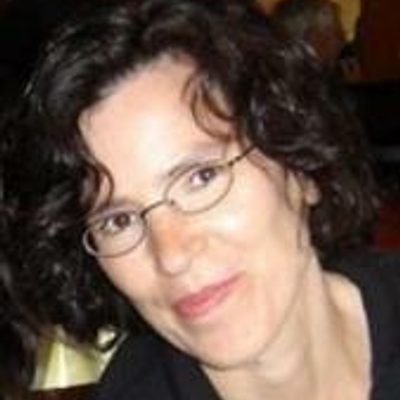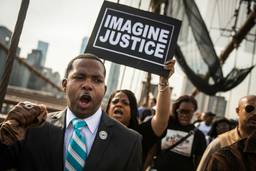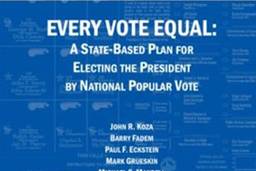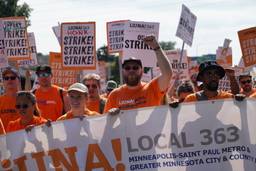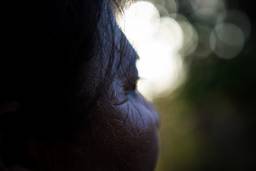From Hope to Disposability
50 years after the March on Washington, we are living with the civil rights movement’s defeats.
Martha Biondi
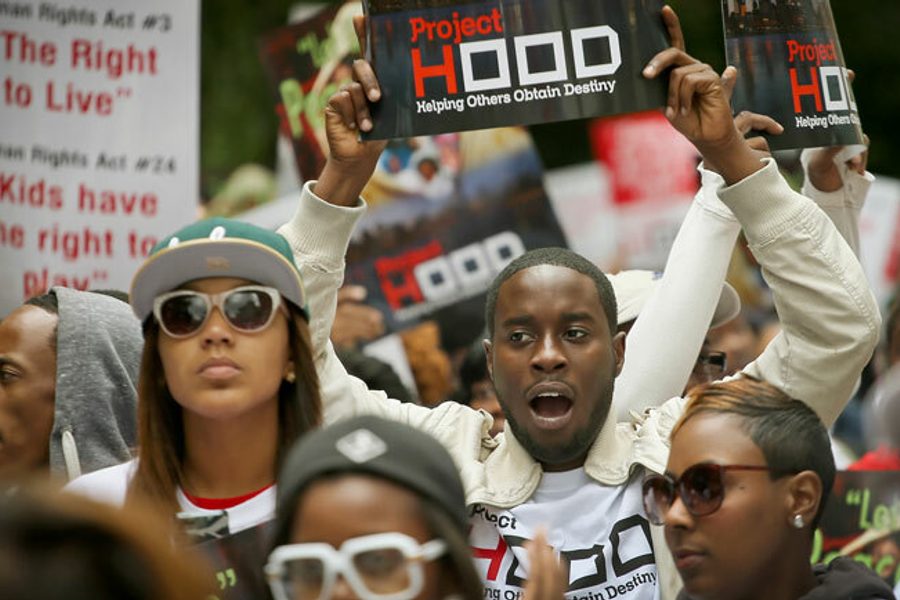
On Aug. 28, 1963, an estimated 250,000 people took to the streets as part of the March on Washington for “Jobs and Freedom.” The march was a historic convergence of the Southern civil rights movement, which emphasized freedom in its fight to dismantle Jim Crow laws and attain voting rights, and the Northern civil rights movement, which emphasized access to jobs and unions, alongside fights for better education and housing, and an end to police brutality.
Since the election of Barack Obama as president, many observers have trumpeted the arrival of a “post-racial” era. But truthfully, and sadly, we are living with the legacy of the civil rights movement’s many losses and defeats. In June, the U.S. Supreme Court sharply delimited the Voting Rights Act and further undercut already constrained efforts to increase Black access to higher education. And then George Zimmerman was acquitted in the shooting death of unarmed Trayvon Martin, a verdict that symbolizes to many a growing disregard for Black life, especially the lives of young Black men.
It may seem odd to argue that there’s a growing disregard for Black life at a time when a Black family occupies the White House. But in a tragic conjuncture, the post-civil rights era has overlapped with the post-industrial era and the rise of neoliberalism in the United States. These developments have precipitated a crisis for young Black and Latino men whose lives are now characterized by a new social condition we might call disposability.
Disposability encompasses not only structural unemployment and the school-to-prison pipeline, but also high rates of shooting deaths as weaponry meets hopelessness in the day-to-day struggle for manhood and survival. Disposability also manifests in our larger society’s apparent acceptance of high rates of premature death of young African Americans and Latinos. As studies of white jurors have shown, white Americans tend to exhibit less empathy with Black people, and tend to downplay the Black experience of bodily pain and injury. Indeed, in some respects, the cultural logic forged during the era of lynching — that the criminalization and murder of Black men underwrites white privilege, particularly a sense of white superiority — endures in our own time.
Guns kill 31,000 Americans a year and injure another 73,000. Handguns have killed more Americans since 1968 than have died in all U.S. wars combined. The majority of shooting death victims between 1980 and 2010 were Black, and today homicide is by far the leading cause of death for young Black men.
Chicago has been one epicenter of this crisis, and a recent study by Daniel Hertz, a graduate student at the University of Chicago, reveals that gun deaths have increasingly come to mark the spatial and racial divide in the city. Between 1990 and 1993, he found, the murder rate in the most dangerous third of the city was six times higher than in the safest third. By 2008-2011, it was 15 times higher. This statistic — particularly shocking for a time when overall crime was declining — shows the concentration of violence in the neoliberal city. Not surprisingly, the neighborhoods with the highest rates of homicides are the non-white ones and are also those without jobs, services, investment and opportunity.
Racism, as scholar Ruth Wilson Gilmore has defined it, is “the state-sanctioned or extra-legal production and exploitation of group-differentiated vulnerabilities to premature death.” This definition demands that we view this staggering loss of life as a social crisis rather than a series of discrete crimes. But it has been difficult to frame it this way. Understandably, many people don’t see the murder of a Black person by another Black person as an example of racism. The racial identity of the perpetrator functions to erase the social context and absolve social conditions of responsibility. “Black on Black crime” has been the more mainstream label attached to this massive loss of life.
The mass killings in white communities in Newtown, Conn. and Aurora, Colo. have episodically galvanized national media attention and intensified pressure on Congress to stem the flow of guns, but invariably the power of the gun lobby has short-circuited federal action. At the same time, the ongoing death toll of young people of color never becomes a moral crisis for the nation.
On the 50th anniversary of the March on Washington, it’s worth examining how African-American communities, civil rights leaders and activists have responded to this crisis. How have they diagnosed the problem and what remedies do they advocate?
Communities step up
Voices on the Right often castigate Black leaders for allegedly turning a blind eye to urban violence in favor of protesting interracial killings. Fox News’ Bill O’Reilly struck this note in his outrage over Black protest in the aftermath of the Zimmerman acquittal. Laura Washington, a Chicago Sun-Times columnist (and In These Times contributing editor), recently echoed this point, writing: “Beyond the Oscars and Trayvons, Black folks fail to acknowledge or take responsibility for the crisis of our own making. In Chicago and many other urban enclaves, far more African-American men and boys are being slaughtered by their own.” Even activists on the Left have suggested that Black leaders have paid insufficient attention to this crisis. At an NAACP event in February, civil rights activist Harry Belafonte criticized Black leaders for not being more visible in leading the fight against the proliferation of guns. He suggested that we have dropped the ball and failed to address the urgent plight of oppressed Black communities.
“Where’s the raised voice of Black America?” he asked. “Why are we mute? Where are our leaders? Our legislators? Where is the church?”
Belafonte is wrong in underestimating the extent to which civil rights leaders, elected officials and grassroots activists have analyzed the problem and advocated comprehensive reforms. Indeed, residents of neighborhoods on the front lines of this violence have generated the most nuanced perspectives. Poor Black communities are rarely depicted as resilient or as offering creative remedies to the multiple crises they face. Nor are their practices of grieving or memorializing the dead given much attention in the major media.
Many grassroots organizations have emerged to address the crisis. Project Orange Tree, founded by Chicago teenagers with the support of local hip hop artist Lupe Fiasco, has as its mission “preserving the lives of youth by raising awareness about structural violence.” These young people believe that structural violence is the root of “deviant behavior.” They reject criminalization as a solution to gun violence and demand comprehensive social remedies.
A documentary on community organizing in Chicago, On the Front Line: Taking Back Our Streets, focuses on residents of impoverished neighborhoods who have declared a “state of emergency” and insist, “We want futures, not funerals.” One group, Kids Off The Block, founded and run by a Chicago mother, is essentially a community center — the kind of initiative that gives young people a meaningful way to spend time that has been eviscerated from urban budgets. Her program, aimed at violence prevention, is reminiscent of the programs that were run by the Black Panther Party in the late 1960s.
In New York City, community-based groups like Save Our Streets, Cease Fire East New York, MAN UP! and the Brooklyn Blizzards have successfully reduced violence. But then the city and state cut funding for those programs, choosing instead to focus resources on stop-and-frisk and other heavy-handed and racist policing tactics. Such grassroots organizations offer a range of perspectives on the causes of gun violence, from the easy availability of handguns to staggering rates of unemployment and the lure of gangs. Some groups, like the Black Star Project in Chicago, emphasize strengthening families and stressing fatherhood as a remedy.
Notably, none of these groups call for more police, incarceration or other punitive responses. Besieged Black communities have broken with the conventional “crime-fighting” response of politicians. Rather than see more cops and prisons as the solution, they increasingly fault the criminal legal system for stoking community-based violence.
In New Jersey, the Newark Anti-Violence Coalition has formulated a compelling and comprehensive approach. It has staged weekly protests for the last four years. The coalition’s five-point plan calls for job creation, teaching kids Black and Latino history, promoting peaceful resolution of disputes among gangs and an end to police brutality, and demands that Mayor Cory Booker declare violence “a public health emergency.” Their goal is to repair and strengthen urban Black communities, not to criminalize them.
Harry Belafonte’s critique also misses the fact that Black elected officials, clergy and civil rights leaders have advocated restricting the flow of weaponry, increasing investments in urban education and job creation, and dismantling what some term the prison-industrial complex. (To be sure, Black politicians, like their white counterparts, often call for more police during spikes in urban violence.)
The 1970s, 1980s and 1990s saw high rates of Black victims of violent crime, but instead of grieving for this loss of life and redoubling efforts to protect and nurture Black youth, the state chose mass incarceration under the banner of the War on Drugs. In 1994, President Bill Clinton signed into law the Violent Crime and Law Enforcement Act, a bill that expanded mandatory minimum sentences and the death penalty, and built more prisons. Disappointingly, then-Sen. Carol Moseley Braun (D-Ill.) sponsored an amendment requiring that juveniles be tried as adults when charged with certain violent offenses. Interestingly, Clinton recently apologized for signing the Defense of Marriage Act, which the Supreme Court struck down earlier this summer. He should also apologize for the deeply damaging 1994 act — legislation that was part of his effort to move the Democratic Party to the right, and which has devastated Black communities and exacerbated the urban crisis.
For the most part, the Congressional Black Caucus and civil rights leaders have denounced this approach to urban crime fighting. In 1994, the caucus put forward an alternative bill emphasizing drug prevention and job creation. But the bleak prediction of Milton Morris, vice president of the Joint Center for Political and Economic Studies, remains true today: “All the solutions before us are either draconian, prison-oriented types of measures or the kind of costly long term violence prevention efforts that I don’t think the society right now has the patience or the will to take on.”
Eric Adams, a former leader of a Black police officers’ organization in New York City and now a state senator, assails the racist policing he witnessed for years in the NYPD. Stop-and-frisk doesn’t target white men in suits, says Adams, but “they’re the ones bringing guns into Black communities.”
“Maybe the reason they can’t stop the flow of guns coming into the community is because no one is checking the people bringing in the guns,” he continues. “When was the last time we heard that the police had apprehended a large cache of guns?” This is why he uses the phrase “ongoing genocidal murder in urban America” to describe what is, in his view, a system that encourages and abets the death of young African Americans and Latinos.
Many ministers and civil rights organizations have led the call for gun restrictions, especially the trafficking of guns made and sold across county and state lines. This has been a long standing theme of Chicago’s Rainbow PUSH Coalition. “Guns come in, jobs go out” is a common refrain at the group’s headquarters on the South Side. PUSH founder Rev. Jesse Jackson Sr. has led many marches to gun shops in the region. He cites the statistic that 1.2 percent of gun dealers sell 57 percent of the handguns used in violent crime. For Jackson and others, the culprits are the suppliers and manufacturers, who reap corporate profits at the expense of Black lives. In 1999, the NAACP filed a class action lawsuit against gun distributors and makers in federal court, but to no avail.
In July, at the 2013 National Summit on Urban Violence convened by the Congressional Black Caucus, Jackson called for the creation of a development bank for urban America that would offer long-term loans at low interest rates, and a revival of the War on Poverty, proposals that echo calls in the 1960s for a Marshall Plan for Black America by the Urban League and an Economic Bill of Rights by Martin Luther King.
Yet Belafonte’s lament that some Black leaders have been quiet in the face of gun violence has a degree of merit. But this reflects a broader American turn toward defining social problems as criminal problems. During the last 30 years, a rapid expansion of prisons has coincided with public policies that have exacerbated poverty and inequality. In addition, the Right has been effective in framing gun violence as Black male criminality and Black community pathology, and the Right’s influence in the media has made it difficult to reframe the terms of debate.
Firearm revisionaries
Black conservative commentator Armstrong Williams links Black family decline and cultural failure to gun violence. “We cannot lay all the blame at the feet of racism,” he writes. “We need to admit that the Black community is committing genocide on itself.” It’s extraordinary that the Right has sometimes used “genocide” to condemn Black people, rather than acknowledging the wholesale social abandonment of poor Black neighborhoods. In 2007, a white rural politician in Pennsylvania, state Rep. Steve Cappelli ®, declared on ABC News: “Whites don’t care about the high rates of Black deaths in cities because it’s cultural genocide.” Even the phrase “Black on Black crime” suggests that a race-based deficiency or cultural failure is to blame for the high death and injury rates of young Black people. This discourse has operated quite effectively to obscure the actual causes of gun violence, putting the focus instead on the supposed failings of vulnerable communities and individuals.
Another factor behind the silence that Harry Belafonte identifies is a desire by some African Americans to defend gun ownership, seeing it as crucial to personal and property rights in crime-ridden communities or as part of a revolutionary tradition of armed self-defense against white supremacist forces like the Ku Klux Klan or American police. (Although to be clear, public opinion polling shows solid Black majorities favor tighter gun control laws.) There is also likely a segment of Black leadership that sees gun ownership in the United States as a prerogative of manhood. Legal scholars Robert Cottrol and Raymond Diamond, seeking to formulate a Black perspective on the Second Amendment, acknowledge that gun restrictions might save Black lives, but write in the Georgetown Law Journal that “a stronger case can be made that society with a dismal record of protecting a people has a dubious claim on the right to disarm them.”
Then there are those who embrace the Black Panther Party’s view of the Second Amendment — as vital to Black people’s protection of themselves against violent police. Interestingly, some conservative pundits and the National Rifle Association have recently begun to appropriate this perspective. The NRA likes to tell Black audiences that its origins were in defending former slaves after emancipation. Niger Innis, the conservative leader of CORE, the Congress of Racial Equality, a civil rights organization that moved to the right beginning in the 1970s, says gun control “sprouts from racist soil.” He emphasizes that Dixiecrats wanted to disarm Black southerners during Jim Crow and warns that “gun control has ultimately been about people control.”
Last summer, the NRA held a major event on Chicago’s South Side to cultivate support for a “conceal and carry” law in Illinois. The framing of the event was steeped in 1960s Black Nationalism, and the crowd was filled with veterans of those struggles, now gray-haired middle-class homeowners. The event organizers screened the documentary Negroes with Guns, chronicling the heroic struggle of Robert F. Williams, the radical advocate of armed self-defense, followed by the propaganda film No Guns for Negroes. Interestingly, when the lights went up, the very first thing that host Cliff Kelley emphasized was that guns today should not be used against the police. No, no, this popular Black radio personality declared, police were not the bad guys and certainly not the enemy of law-abiding Black residents. The enemy was gang-bangers (and this was said again and again) who were taking over previously safe and peaceful communities. So, apropos of Naomi Klein’s “shock doctrine” theory, that the NRA — a conservative and, let’s be honest, paramilitary organization— was able to go into a beleaguered community reeling from disinvestment and portray itself as a friend and as a savior. And it was a pretty effective pitch.
Of course the solutions to this problem, just like the roots of this problem, are complex, and we would be wise to listen carefully to the residents and activists living on the front lines of urban warfare. Holistic, nuanced and comprehensive, their remedies are inspired by a fierce commitment to Black humanity — a stance at odds with the logic of disposability. Moreover, any struggle against violence in the United States must at every instance also be a struggle against the endless war making of the American empire. Making guns and killing people at home and abroad is big business, and we should never lose sight of this dual focus.
It is perhaps timely and appropriate to revisit some of the demands made at the March on Washington. Two in particular are as relevant today as they were in 1963: One called for a “massive federal program to train and place all unemployed workers — Negro and white — on meaningful and dignified jobs at decent wages.” Another sought a “national minimum wage act that will give all Americans a decent standard of living.”
A federal jobs program and national living wage would go a long way toward reestablishing the relationship between Black and Latino workers and the American social compact. They would constitute a powerful affirmation of a revitalized commonweal and send the message that as a society we value and affirm Black and brown bodies and families and communities and seek to build a new society based on the prophetic witness of Martin Luther King, Ella Baker, A. Philip Randolph, Bayard Rustin, and all who made freedom such a potent aspiration at the March on Washington.
